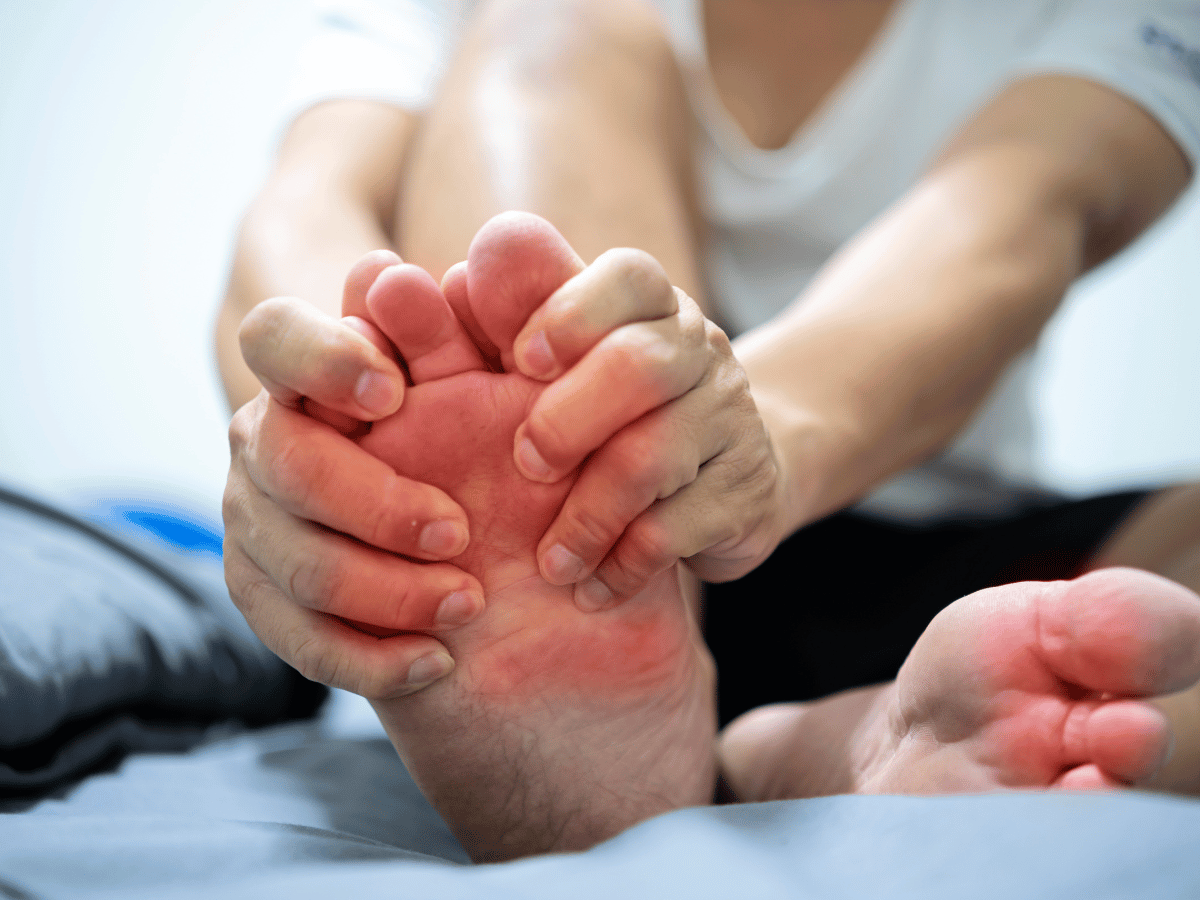
Pseudogout, also known as calcium pyrophosphate deposition disease (CPPD), is a type of inflammatory arthritis. It occurs when calcium pyrophosphate crystals accumulate in the joints, causing sudden pain, stiffness, swelling, and redness. These episodes are called flare-ups or acute attacks.
While it shares similarities with gout, in which uric acid crystals collect in the joints, pseudogout is caused by a totally different kind of crystal. And that distinction is more than just academic, it changes how we diagnose and treat the condition.
We often hear people confuse pseudogout with gout, and at first glance, that’s understandable. Both flare up suddenly. Both cause red, swollen joints. And both can dramatically impact quality of life if untreated.
However, the key distinction is in the type of crystal depositing in the joint:
Also, gout primarily targets the big toe and small joints of the foot or hand. Pseudogout, on the other hand, most often affects larger joints, especially the knees, wrists, shoulders, and hips.
Why do some people develop these troublesome crystals in their joints?
CPPD crystal accumulation isn’t fully understood, but several risk factors and conditions are associated with its development:
These conditions either alter the composition of joint fluid or affect how crystals form, increasing the likelihood of CPPD deposition.
The signs of pseudogout can sneak up on us. What starts as a little stiffness or joint tenderness can quickly turn into a full-blown flare.
Tell-tale symptoms include:
While pseudogout attacks typically come on without warning, they can sometimes be triggered by physical stress like surgery or illness. Repeated flares may damage the joint over time, leading to chronic pain or stiffness.
Diagnosing pseudogout requires a close look—literally and figuratively—inside the joint.
Here’s how healthcare professionals usually evaluate:
Early diagnosis is essential so we can tailor treatment effectively and prevent long-term joint damage.
Managing pseudogout is all about controlling the inflammation during flare-ups and preventing future episodes.
Typical treatment options include:
While there’s no cure for pseudogout, these treatments can greatly reduce discomfort and improve joint function.
We have good news—our daily habits can help manage pseudogout and reduce the likelihood of flares.
Simple lifestyle changes may include:
Also, managing underlying metabolic issues like thyroid dysfunction or calcium/magnesium imbalance is crucial.
There’s no guaranteed way to prevent every pseudogout flare, but proactive care can help us stay one step ahead.
Here’s what we typically recommend:
With the right combination of treatment, monitoring, and lifestyle adjustments, most people with pseudogout lead active, fulfilling lives.
However, chronic CPPD can result in joint damage, mimicking osteoarthritis. That’s why early treatment, accurate diagnosis, and joint protection are so important. In some cases, long-term preventive medications or physical therapy may be needed.
Think of managing pseudogout not as a short-term fix, but as a journey. One that requires patience, good communication with your care team, and a strategic approach to inflammation control.
Don’t dismiss sudden joint pain as just a passing ache. If you notice:
…it’s time to reach out. Timely evaluation could prevent future damage, improve mobility, and greatly enhance quality of life.
Joint pain doesn’t have to take away your independence or quality of life. If you’re dealing with the symptoms we’ve discussed, South Florida Multispecialty Hospital is here to help. Our expert rheumatologists provide comprehensive care to accurately diagnose and personalize treatment plans for conditions like pseudogout.
Let’s take action together. If you’re experiencing recurring joint pain or suspect you may have pseudogout, book a consultation today.
Concerned about joint pain, swelling, or stiffness? Contact South Florida Multispecialty Group for expert evaluation and personalized pseudogout treatment.
Pseudogout is an inflammatory arthritis caused by calcium pyrophosphate crystals, while gout stems from uric acid crystals. Pseudogout often affects larger joints like knees and shoulders, unlike gout, which commonly involves the big toe.
These crystals form due to chemical imbalances in joint fluid. Age, joint trauma, and conditions like hyperparathyroidism or hemochromatosis increase the risk.
Sudden joint pain, redness, swelling, and reduced range of motion, often in the knees or wrists.
The knees are most frequently affected, followed by wrists, shoulders, elbows, and hips.
Seek medical attention if you experience sudden joint swelling, redness, and severe pain, especially if symptoms persist or worsen.
Diagnosis involves joint fluid analysis to detect calcium pyrophosphate crystals, along with imaging studies like X-rays for chondrocalcinosis.
Treatment includes NSAIDs, colchicine, and corticosteroids. Managing underlying causes and adopting joint-friendly habits also help.
Yes. Regular exercise, proper hydration, managing weight, and treating metabolic disorders can minimize flare-ups.
Yes. These include hyperparathyroidism, hemochromatosis, hypothyroidism, and magnesium deficiency.
While pseudogout can be recurrent, proper treatment can reduce flare frequency and preserve joint function.
Your well-being is our top priority. Reach out today to discover how our dedicated team can support your health journey.
Have questions or want to learn more? Use the form below to get started!
Connect with South Florida’s trusted multispecialty care team and take control of your health with compassion and convenience.
©2025 South Florida Multispecialty Medical Group. All Rights Reserved.